Notes from Mathilde Scholl 1904–1906
GA 91
27 September 1906, Landin
Automated Translation
34. The Spiral The number 3.1415
The line of all development is the spiral. Its loops always follow the same laws. We can regard the spiral as the living representation of the ratio of the diameter to the circle. The first loop of each spiral arises from the fact that a line describes a circle, but not a perfect circle. Before it closes again, it turns away from the end point to describe a circle again and so on in this way. If we imagine this figure stretched out, we have a spiral.
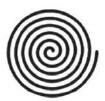
The development of the same can be observed on a paper spiral. Each arc of a spiral is therefore created by curving a straight line, but not entirely back into itself, but by simultaneously lengthening this curved straight line. So each arc of the spiral is in the same ratio to the straight line that curves as the circle is to the diameter, as the number \(\pi\) is.
Now, every circle diameter can be placed on the circle three times with a remainder, so the diameter, by extending and curving three times, can almost close to a circle, but not quite; a gap remains, and indeed corresponding to the number \(\pi\); the gap is what follows after \(3\), namely \(1\), \(4\), \(1\), \(5\) and so on. So, to complete the circle, we need the numbers after the decimal point of the number \(\pi\), i.e. \(1415\) etc. Now, in terms of their values, these are \(1/10\), \(4/100\), \(1/1000\), \(5/1000\) of the original diameter, but since the number x is infinite, there is no number that expresses how much of the diameter can be placed on the circle. We can now imagine a process in which the diameter is bent to the circle so far until it almost closes, and where only the small gap remains open, which contains the numbers \(0,1415\) and so on. The number \(1\) denotes here \(1/10\) of the diameter.
If now the diameter, where it has reached the gap, i.e. after it has been placed on the circumference three times, continues in the same ratio, it describes a line that is in the ratio of the whole diameter to \(1/10\), \(4/100\), \(1/1000\), \(5/10000\) and so on. If at the same time it deviates from the perfect first circle at the point where this line begins, it will continuously form a spiral.
If this is the diameter of the first vibration,

then it describes the following circle; and when it turns into a spiral, the following spiral.
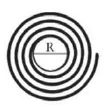
The spiral arises from the deviation of the diameter from the formation of a circle in the ratio of \(1/10\), \(4/100\), \(1/1000\), \(5/10000\) to a length. - If the diameter emerges from a circle, then it can only emerge from the circle in the ratio of the number \(\pi\), namely as often as it is contained in the circle. We can imagine that the circle is movable, like a circle formed by a [illegible] or a band. If you pull the band from one point with one end through the center in the direction of the diameter of the circle, it moves from the circumference in this direction.
A movable semicircle is formed, which becomes smaller and smaller. You could also continue to pull the tape in a circle, then a spiral would form.

Thus every spiral arises through the number \(\pi\), which expresses the ratio of [circumference to diameter] or the infinitely small deviation from the circular line to the straight line. A spiral is therefore the line that arises from the diameter emerging from the circle.
The number \(\pi\) expresses the ratio of the diameter to the circle. According to the numbers of this ratio, it can now also emerge from the circle, since all development arises from the fact that a force expresses itself in this ratio according to the number \(3.1415\).
If a force remained closed in itself, no revelation would be possible. To reveal oneself means to unlock oneself. Every closed force can only unlock itself through this ratio of its diameter to its perimeter. The circumference circumscribes the entire force, while the diameter divides the entire force into two halves. The force that divides the whole into two halves is not fully contained within it; it is related to it in the same way as the number \(\pi\). The effect of the dividing, revealing force thus emerges according to the numbers \(3,1415\).
Since it has retained in the first force the endeavor to close again into a whole, it will again try to describe a circle. But since it has within itself the endeavor to overcome unity, it deviates again from the circular line and thus describes a spiral.
The force of the second spiral line is twisted to the same extent as it moves away from the first force, namely in the ratio of the number \(\pi\). If the first circle is the force \(3.1415\), then the second circle of the force is contained in the first as often as the number \(\pi\), the third in the second again as often as the number \(\pi\). The second spiral line of force can emerge from the first \(3.1415\) times. The third force can emerge from the second \(3.1415\) times, from the third the fourth and so on. - In this ratio, the force on spiral lines decreases. The emergence of force occurs in the ratio of arithmetic numbers up to \(5\). If we multiply a force by the number \(3.1415\), then it becomes the next higher force; the lower force always indicates the diameter of the higher force, the higher force is \(3.1415\)-times the circumference of the lower force. The diameter of the higher force is always the circumference of the lower force. The strength of a force decreases in proportion to the squares of its distance. The reduction in strength can therefore be calculated by raising the distance from the first force to the second power.
The distance from the center of the force indicates the radius of the circle, half the diameter. This must be squared to know how strongly the force in the center acts on the circumference. If the diameter is \(4\), then the radius is \(2\), the square is \(4\) - so the force on the circumference is \(1/4\) of that in the center. If the radius is 100, then the square is 10,000, so the force on the circumference is 1/10,000 of the central force. We can express the forces as a ratio, and the force effects.
If the circumference is \(18\), then the diameter is contained in it \(3.1415\) times, so it is a little [less] than \(6\). Let us assume that it is \(6\) – then the radius would be \(3\), the square would be \(9\) – the force effect in the circumference would be \(1/9\) of the force inside, but a little less than \(1/9\).
Thus, one force after another emerges in the ratio of the number \(\pi\) – but each following force is only \(3.1415\)th the magnitude of the previous one – and each force is in the ratio of the square of the radius, which indicates the distance of the circumference from the center.
All cosmic forces are connected in this way. The descent is a continuous revelation that reveals itself as \(3.1415\) [whereby] the inner diameter of the higher force becomes the circumference of the next one, creating a spiral in which the next loop is always only the \(3.1415\)th part of the previous one. The diameter of the higher force forms the circumference of the lower force. The circumference of the smaller force is therefore the diameter of the larger force. Since the circumference of the total force is the same as the diameter of the larger force, half the circumference of the smaller force is equal to half the diameter of the larger force. Half the circumference of the smaller force therefore indicates the distance of the larger force circumference from the center - consequently, you only need to square half the circumference of a force to find the force effect of a larger force.
If the magnitude of a force is \(10\), then half the magnitude is \(5\) – in this case, the force of the higher force is \(5^2 = 25\).
Conversely, we can calculate the range of the lower force from the range of the higher force. If the range of a force is \(25\), then its radius is \(5\), its diameter is \(10\), and consequently \(10\) is the range of the lowest force that arises from it. So \(10\) is the diameter of the higher force and the circumference of the next force. From \(10\) the diameter now emerges, corresponding to the number \(\pi\), as a little less than \(1/3\) of \(10\) – to form the circumference of the following force. So the force that follows has approximately \(3\).
Thus, by means of the number \(\pi\), one can calculate all the ratios of the forces that arise from each other and their effects. Thus, the cosmic substances and forces interlock and swirl around each other in spiral lines, whereby, on the one hand, a transformation of force occurs in that the diameter emerges from the circle \(3.1415\) times – or, on the other hand, an increase in force occurs in that the circle becomes the diameter of a higher force. Furthermore, on the one hand the radii are raised to a higher power, squared to the force, and – or on the other hand, the square of the force is taken to the root of the radius of the circle that it describes. Range of force
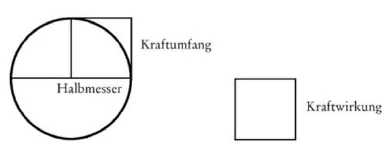
Force effect
squaring the circle?
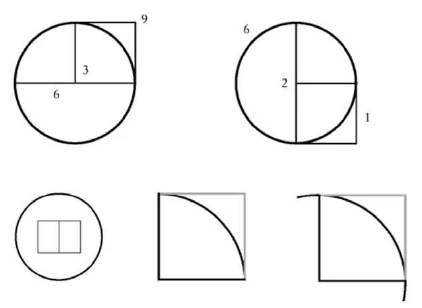
The diameter is related to the force effect in the same way as the semicircle \(\times 2\) is related to the semicircle squared. If the [radius] is \(x\), then the diameter is \(x \times 2\) and the force is \(x^2\). Therefore, the diameter to the force is in the ratio of \(2 \times x\) to \(x^2\) or the diameter is \(\sqrt{x^2} \times 2\).
\(x^2\) force effect
\(\sqrt{x^2} =\) radius \(= x\)
\(x \times 2 =\) diameter
Thus, \(\sqrt{x^2}\) indicates the radius and \(\sqrt{x^2} \times 2\) indicates the [diameter] of a force whose effect on the circumference is equal to the content of the force shape raised to the power of \(x^2\). The effect decreases from the center to the circumference of the circle in the ratio of \(x^2\) raised to the power of the radius squared.
Since the diameter of a force forms the circumference of the next force arising from it, \(x \times 2\) is also the circumference of the next lesser force.
If a force is equal to \(9\), then the radius is \(3\), the diameter is \(6\), and the resulting force is again equal to \(6\) in magnitude, and the radius is approximately \(1/3 = 2\). If the radius is \(1\), then the force is equal to \(1\), because \(1^2 = 1\). So if the diameter is \(2\), the force is \(1\).
The circle represents the number \(10\). The next number is \(9\), the square of \(3\). So \(3^2 =\) \(9\), almost \(10\), the closest to \(10\). The next approximation to the circle is the square drawn inside the circle. The ratio of the square to the circle is like \(9\) to \(10\) or like \(3 \times 3\) to \(3 \times 3.1415\). The circle is therefore more powerful by \(1/10\), \(4/100\), \(1/000\), \(5/10000\), etc. than the square, which has the same diameter.
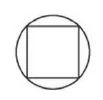
(1/3) of the circumference forms the circumference of the next power that emerges from it, so approximately (1/3). The circumference must divide into three approximately to form the next power that emerges. This results in the tripartite division of power, which is indicated by the  .
.
If we now raise the diameter of the force, which is 3 x 3.1415 in the circumference, to the square, the  , but also the \(9\).
, but also the \(9\).
Just as the \(9\) is the precursor to perfection, so in this sense the square symbolizes \(3 \times 3\), the next step towards perfection, the transition to the \(10\), the circle, because the circle in the square is the \(10\) in the \(9\).
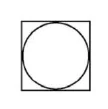
\(3 \times 3 = 9\)
\(3 \times 3,1415 = 10\)
Actually, \(3 x 3\) can be represented as follows:
\(||\) form only one direction – a diameter raised to the square 
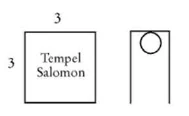
sun
circle in the temple
spiritual man
in the physical man
or also
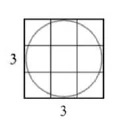
The \(3 \times 3\) represents the stages of the ascent to the perfection of man - the three human powers raised to the square; to complete only [three times] the \(0.1415\) is missing. - The spiritual man is the closed circle, the physical man stepping out of the circle square - the spiritual man is the \(10\), the physical man is the \(9\). (Zodiac arranged on the sides of the square gives the \(12\).)
The circle in the square is the spiritual man emerging from the physical as the sun shining out of the temple.
Circle and square have the same diameter; we find the force effect of the circle by halving the diameter and exponentiating it.
The radius squared is the force effect, and thus also the ratio of the force reduction. The force effect is distributed in the physical square according to the square of the radius in the circle. So to find the force effect in the physical, you have to draw another circle around the square and raise the radius of this circle to the square, thus:

The physical force effect is all the less, as the square of the radius in the outer circle is greater than the square of the radius in the inner circle.
The spiral, emerging from itself, deviates from the direction of the circle at every point of its line by \(0.1415\) and so on. Through this continued deviation of a line in each point in the ratio of \(0.1415\) in relation to the circular line, the spiral arises. Or a spiral arises from a straight line when it turns in the reverse ratio of the circular line.
The spiral forms the relationship between straight line and circle; it is the union of a straight direction and a circular line. When a spiral is closed, the force rests entirely within it; when it unrolls, the force emerges. It decreases to the extent that it emerges, in proportion to the square of the distance of the end point of the spiral from the beginning.
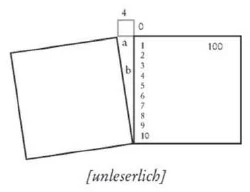
Force \(a\) is divided by \(4/4\) up to \(10\)
Force \(b\) is divided by \(1/100\) at \(x\)
Force \(a = b\)
\(= 4 \cdot 100 \cdot 25\)
so \(b 20x\) is as great as \(a\)
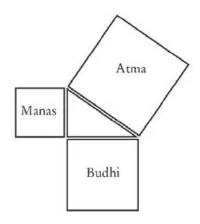
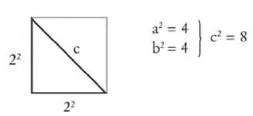
A force always acts in the same direction as the hypotenuse of two forces that intersect at right angles.
If we break down a force into two forces, these forces must intersect at right angles.
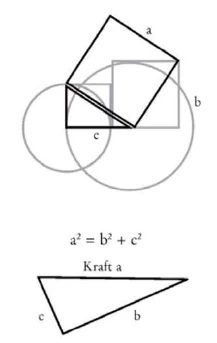
The square of the force of the hypotenuse a is equal to the sum of the squares of the forces \(b\) and \(c\). The right angle is always the projection of two forces that arise from one force, of two forces that are equal to one force.
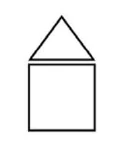
Every angle that touches the tip of the periphery, the sides of the diameter and the periphery of a circle is a right angle.
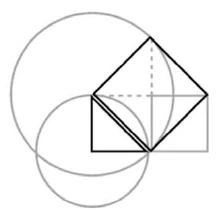
A square is created by constructing two opposite angles in a circle so that they intersect the sides of the diameter and the periphery.
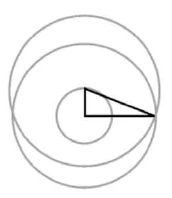
The two catheti circles have the same center. The hypotenuse circle touches the small circle at the center of the large one on the periphery.

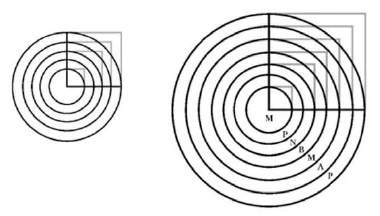
Force square – the decline of force from the Mahapara Nirvana plane to the physical plane.
Comet: the life of higher beings in particular, without regeneration.
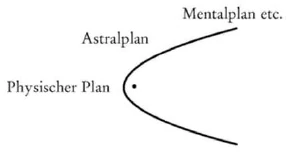
Parable - detached from the whole and not complementing anything. The forms of new life are

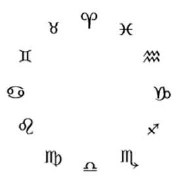
All signs of the zodiac are pieces cut out of the spiral. The same applies to the numbers \(1, 2, 3, 4, 5, 6, 7, 8, 9, 10, 11, 12\).
The Roman numerals represent only the unit and duality, the cone, the development process in the whole. \(I, II, III, IV, V, VI, VII, IX, X, XI, XII\).
Only \(I\) and \(X\) are independent signs. All others are composed of these. \(V\) is the \(X\) halved. The \(I\) is the beginning, the primal force. \(V\) is revelation, the deepest descent. \(X\) is completion, where the halved force \(V\) has reunited with the other half: \(X\).
The 7 planets

As long as a person lives in the physical, their consciousness is turned away from the spirit. The spiritual is a focus in an ellipse, the physical is the other.

But the spiritual encompasses the physical. The life of the etheric body with Pranayama overcomes this focus on the physical and turns it towards the spiritual, while the spiritual flows towards it.

The consciousness of the astral body, Kama, finds the connection with the spiritual, and the physical and spiritual merge.

In astral consciousness, the human being stands where these two currents intersect. It is as if he were standing in the middle between two sides of a plane of symmetry. He no longer sees the physical as we see it, but from the other side. But he also does not yet see the spiritual as the spiritual consciousness does, but – also from the other side – as it manifests itself in the soul.
When a person is spiritually conscious, he is at the center of the spirit itself, and his consciousness goes out from this center in all directions. Physical consciousness acts in one direction, soul consciousness acts in two directions. Spiritual consciousness acts in all directions as from the center. Physical consciousness is life on the outside, soul consciousness is life on the inside, and spiritual consciousness is penetration into the center.
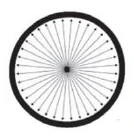
In physical consciousness, man stands in relation to the physical world, so that he is a part of it. In the soul, he lives within himself, detached from the world; in the spiritual, he moves back into the world, but into the other side of it. Now he is not only a part of the world, but unites from the center with all parts of the spiritual world. It is as if he lived in the physical on earth, in the soul within himself, in the spiritual in the earth. Physically he perceives things, in his soul he relates to them, spiritually he lives in them. Physically he is separate from things, in his soul he lets them pass through himself \(\infty\), spiritually he moves into things.
All things around him are physically shaped spiritual archetypes that have undergone the reverse process from the spiritual to the physical, through the soul of man. The physical forms owe their diversity to the fact that they are varied in the soul of the person who received them from the spirit, allowed them to pass through him and physically separated them out. The fact that we appear in different forms in different incarnations is because our spiritual archetype passes through the soul and thereby receives the imprint that makes it appear in a different physical form in each incarnation. The archetype is always the same; it is the actual name of the person. The more the soul moves towards the spirit, the more the physical incarnation resembles the spiritual archetype.
The spiritual archetype of the person is connected to the twelve signs of the zodiac and to the sun and the forces that arise from it. The soul in man is related to the moon and the seven planets. These forces modify the spiritual ones. The physical expression of the \(12 + 1\) spiritual and the \(7 + 1\) soul forces is the physical human being, arranged in the pentagram, which thus expresses seven soul and twelve spiritual forces.
The seven soul forces and five sense forces interweave to form the twelve spiritual forces.
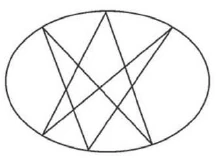
34. Die Spirale Die Zahl 3,1415
Die Linie aller Entwicklung ist die Spirale. Ihre Schleifen folgen immer denselben Gesetzen. Die Spirale haben wir anzusehen als dasjenige, was das Verhältnis des Durchmessers zum Kreise lebendig darstellt. Die erste Schleife jeder Spirale entsteht dadurch, dass eine Linie einen Kreis beschreibt, aber nicht einen vollkommenen Kreis, sondern ehe sie sich wieder schließt, wendet sie sich ab vom Endpunkt, um wieder einen Kreis zu beschreiben und so weiter in dieser Weise. Wenn wir uns diese Figur auseinandergezogen denken, haben wir eine Spirale.

An einer Papierspirale lässt sich die Entwicklung derselben beobachten. Jeder Bogen einer Spirale ist also entstanden durch Krümmung einer geraden Linie, aber nicht ganz in sich selbst zurück, sondern indem diese gekrümmte gerade Linie zugleich sich verlängert. Also steht jeder Bogen der Spirale zu der geraden Linie, die sich krümmt genau in dem Verhältnis wie der Kreis zum Durchmesser, wie die Zahl \(\pi\).
Nun kann jeder Kreisdurchmesser dreimal mit einem Rest auf den Kreis gelegt werden, also kann der Durchmesser, indem er dreimal sich verlängert und krümmt, sich beinahe zum Kreise schließen, aber nicht ganz, eine Lücke bleibt, und zwar entsprechend der Zahl \(\pi\); die Lücke ist das, was nach der \(3\) folgt, nämlich die \(1\), die \(4\), die \(1\), die \(5\) und so weiter. Es bleiben also übrig, um den Kreis abzuschließen, die Zahlen, die hinter dem Komma stehen bei der Zahl \(\pi\), also \(1415\) etc. Nun sind die ihrem Werte nach \(1/10\), \(4/100\), \(1/1000\), \(5/1000\) des ursprünglichen Durchmessers, aber da die Zahl x unendlich ist, so gibt es keine Zahl, die ausdrückt, wie viel vom Durchmesser auf den Kreis gelegt werden kann. Wir können uns nun einen Vorgang denken, wo der Durchmesser zum Kreise so weit gekrümmt wird, bis er sich fast schließt, und wo nur die kleine Lücke offen bleibt, die die Zahlen \(0,1415\) und so weiter enthält. Die Zahl \(1\) bezeichnet hier \(1/10\) des Durchmessers.
Wenn nun der Durchmesser da, wo er bei der Lücke angelangt ist, also nachdem er dreimal auf den Kreisumfang gelegt worden ist, im selben Verhältnis sich fortsetzt, beschreibt er also eine Linie, die im Verhältnis zu dem ganzen Durchmesser steht mit \(1/10\), \(4/100\), \(1/1000\), \(5/10000\) und so weiter. Wenn er zugleich an der Stelle, wo diese Linie beginnt von dem vollkommenen ersten Kreise abweicht, so bildet er fortgesetzt wieder eine Spirale.
Wenn dies der Durchmesser der ersten Schwingung ist,

so beschreibt er folgenden Kreis; und wenn er sich zur Spirale abwendet, folgende Spirale.

Die Spirale entsteht aus der Abweichung des Durchmessers von der Kreisbildung im Verhältnis von \(1/10\), \(4/100\), \(1/1000\), \(5/10000\) zu einer Länge. - Wenn nun der Durchmesser aus einem Kreise hervortritt, so kann er auch nur in dem Verhältnis der Zahl \(\pi\) aus dem Kreise hervortreten, nämlich so oft er im Kreise enthalten ist. — Wir können uns vorstellen, der Kreis sei beweglich wie zum Beispiel ein durch eine [unleserlich] gebildeter Kreis oder ein Band. Zieht man das Band von einer Stelle an mit einem Ende durch die Mitte gerade durch in der Richtung des Kreisdurchmessers, so bewegt es sich von dem Umfang her weiter in dieser Richtung.
Es bildet sich ein beweglicher Halbkreis, der immer kleiner wird. Man könnte das Band auch selbst im Kreise weiterziehen, dann bildete sich eine Spirale.

So entsteht jede Spirale durch die Zahl \(\pi\), welche das Verhältnis vom [Kreisumfang zum Kreisdurchmesser] ausdrückt oder die unendliche kleine Abweichung von der Kreislinie zur geraden Linie. Eine Spirale ist also die Linie, die durch das Heraustreten des Durchmessers aus dem Kreise [entsteht].
Die Zahl \(\pi\) drückt das Verhältnis aus, in dem der Durchmesser zum Kreise steht. Entsprechend den Zahlen dieses Verhältnisses kann er auch nun aus dem Kreise heraustreten, da nun alle Entwicklung entsteht dadurch, dass in diesem Verhältnis eine Kraft sich äußert nach der Zahl \(3,1415\).
Würde eine Kraft in sich geschlossen bleiben, so wäre keine Offenbarung möglich. Sich offenbaren heißt sich aufschließen. Jede geschlossene Kraft kann sich nur aufschließen durch dieses Verhältnis ihres Durchmessers zum Umkreis. Der Umkreis umschreibt die ganze Kraft, der Durchmesser teilt die ganze Kraft in zwei Hälften. Die Kraft, welche die ganze in zwei Hälften teilt, ist nicht ganz in ihr enthalten, sie steht zu ihr in dem Verhältnis wie die Zahl \(\pi\). Die Wirkung der teilenden, der offenbarenden Kraft tritt also hervor nach den Zahlen \(3,1415\).
Da sie in der ersten Kraft das Bestreben erhalten hat, sich wieder zu einem Ganzen abzuschließen, wird sie wieder versuchen, einen Kreis zu beschreiben. Da sie aber in sich das Bestreben hat, die Geschlossenheit zu überwinden, weicht sie wieder von der Kreislinie ab und beschreibt so eine Spirale.
Die Kraft der zweiten Spirallinie ist im selben Maße verwunden, wie sie sich von der ersten Kraft entfernt, und zwar im Verhältnis der Zahl \(\pi\). Wenn nun der erste Kreis die Kraft \(3,1415\) ist, dann ist der zweite Kreis der Kraft so oft im ersten enthalten wie die Zahl \(\pi\), der dritte im zweiten wieder wie die Zahl \(\pi\). Die zweite Spirallinie der Kraft kann aus der ersten \(3,1415\)-mal hervortreten. Aus der zweiten kann die dritte Kraft 3,1415-mal hervortreten, aus der dritten die vierte und so fort. - In diesem Verhältnis steigt die Kraft auf Spirallinien abwärts. Das Hervortreten der Kraft geschieht im Verhältnis der arithmetischen Zahlen bis zur 5. Wenn wir eine Kraft multiplizieren mit der Zahl \(3,1415\), dann wird sie die nächsthöhere Kraft; die niedere Kraft zeigt immer den Durchmesser der höheren Kraft an, die höhere Kraft ist \(3,1415\)-mal der Umfang der niederen Kraft. Der Durchmesser der höheren Kraft ist immer der Umfang der niederen Kraft. Eine Kraftwirkung nimmt ab im Verhältnis der Quadrate ihrer Entfernung. Die Kraftverminderung kann man also berechnen dadurch, dass man die Entfernung von der ersten Kraft ins Quadrat erhebt.
Die Entfernung von Mittelpunkt der Kraft zeigt bei dem Kreise der Halbmesser an, die Hälfte des Durchmessers. Diese muss man in das Quadrat erheben, um zu wissen, wie stark die Kraft im Mittelpunkt auf den Umfang wirkt. Ist der Durchmesser \(4\), so ist der Halbmesser \(2\), das Quadrat \(4\) - die Kraftwirkung im Umfang also \(1/4\) von der in der Mitte. Ist der Halbmesser \(1\)00, so ist das Quadrat \(10 000\), also die Kraftwirkung auf den Umfang \(1/10 000\) der Zentralkraft. Wir können in ein Verhältnis bringen die Kräfte, wie sie aus einander folgen, und die Kraftwirkungen.
Ist der Umfang \(18\) so ist der Durchmesser darin \(3,1415\)-mal enthalten, also etwas [weniger] als \(6\). Wir nehmen an, es wäre \(6\)- dann wäre der Halbmesser \(3\), das Quadrat \(9\) - die Kraftwirkung im Umfang \(1/9\) der Kraft im Innern, aber etwas weniger als \(1/9\).
So geht eine Kraft nach der andern hervor in dem Verhältnis der Zahl \(\pi\) - aber jede folgende Kraft ist nur den \(3,1415\)ten Teil der vorhergehenden groß - und jede Kraftwirkung steht im Verhältnis des ins Quadrat erhobenen Halbmessers, welcher die Entfernung des Umkreises vom Mittelpunkt angibt.
Alle kosmischen Kräfte sind in der Weise im Zusammenhang. Der Abstieg ist eine beständige Offenbarung, die sich zeigt als \(3,1415\) [wobei] der innere der Durchmesser der hohen Kraft zum Umfang der nächsten wird und wodurch eine Spirale entsteht, bei der die nächste Schleife immer nur den \(3,1415\)ten Teil der vorhergehenden bildet. Der Durchmesser der höheren Kraft bildet den Umfang der geringeren. Der Umfang der geringeren ist also der Durchmesser der höheren. Da der Umfang der ganzen Kraft ebenso groß ist wie der Durchmesser der höheren Kraft, so ist der halbe Umfang der geringeren Kraft gleich dem Halbmesser der höheren Kraft. Der halbe Umfang der geringeren Kraft gibt also die Entfernung des höheren Kraftumfanges vom Mittelpunkt an - folglich braucht man nur den halben Umfang einer Kraft ins Quadrat zu setzen, um die Kraftwirkung einer höheren Kraft zu erfahren.
Ist der Umfang eine Kraft \(10\), dann ist der halbe Umfang \(5\) — dann ist die Kraftwirkung der höheren Kraft \(5^2 = 25\).
Umgekehrt können wir aus der Kraftwirkung der höheren Kraft den Umfang der niederen Kraft berechnen. Ist die Kraftwirkung einer Kraft \(25\), so ist ihr Halbmesser \(5\), ihr Durchmesser \(10\), folglich bildet \(10\) den Umfang der untersten daraus hervorgehenden Kraft. \(10\) ist also der Durchmesser der höheren und der Umfang der nächstfolgenden Kraft. Aus der \(10\) geht nun entsprechend der Zahl \(\pi\) der Durchmesser hervor als etwas weniger als \(1/3\) von \(10\) — um den Umfang der darauffolgenden Kraft zu bilden. Die darauf [folgende] Kraft hat also ungefähr \(3\).
So kann man vermittels der Zahl \(\pi\) alle Verhältnisse der auseinander hervorgehenden Kräfte und ihrer Wirkungen berechnen. So schieben sich die kosmischen Substanzen und Kräfte ineinander und wirbeln umeinander in Spirallinien, wobei immer wieder einerseits Kraftverwandlung eintritt, indem der Durchmesser aus dem Kreise hervortritt \(3,1415\)-mal -, oder in der andererseits Krafterhöhung eintritt, indem der Kreis zum Durchmesser einer höheren Kraft wird. Ferner werden einerseits die Halbmesser potenziert, ins Quadrat erhoben zur Kraft und — oder andererseits wird das Quadrat der Kraft radiziert zum Halbmesser des Kreises, den sie beschreibt. Kraftumfang

Kraftwirkung
Quadratur des Kreises?

Der Durchmesser steht zur Kraftwirkung in dem Verhältnis wie der Halbkreis \(\times 2\) zu dem Halbkreis ins Quadrat gesetzt. Ist der [Halbmesser] \(x\), so ist der Diameter \(x \times 2\) und die Kraftwirkung \(x^2\). Also steht der Durchmesser zur Kraftwirkung im Verhältnis von \(2 \times x\) zu \(x^2\) oder der Durchmesser ist \(\sqrt{x^2} \times 2\).
\(x^2\) Kraftwirkung
\(\sqrt{x^2} =\) Halbmesser \(= x\)
\(x \times 2 =\) Durchmesser (Diameter)
\(\sqrt{x^2}\) gibt also den Halbmesser an und \(\sqrt{x^2} \times 2\) den [Durchmesser] einer Kraft, deren Kraftwirkung am Umfang gleich dem Inhalt der Kraftgestalt durch \(x^2\) ist. Die Wirkung nimmt vom Zentrum nach dem Umfange des Kreises hin ab im Verhältnis von \(x^2\) vom Halbmesser ins Quadrat erhoben.
Da nun der Durchmesser einer Kraft den Umfang der nächsten daraus hervorgehenden bildet, so ist also \(x \times 2\) auch der Umfang der nächsten geringeren Kraft.
Ist eine Kraftwirkung \(9\), dann ist der Halbmesser \(3\), der Durchmesser \(6\), die daraus hervorgehende Kraft ist dann wieder dem Umfang nach \(6\), der Radius ungefähr \(1/3 = 2\). [Ist] der Halbmesser \(1\), [dann ist] die Kraftwirkung gleich \(1\), denn \(1^2 = 1\). Also wenn der Durchmesser \(2\) ist, ist die Kraftwirkung \(1\).
Der Kreis stellt dar die Zahl \(10\). Die nächste Zahl ist \(9\), das Quadrat von \(3\). \(3^2 =\) also \(9\), beinahe \(10\), der \(10\) am nächsten. Die nächste Annäherung an den Kreis bildet das in den Kreis gezeichnete Quadrat. Das Verhältnis vom Quadrat zum Kreis ist wie \(9\) zu \(10\) oder wie \(3 \times 3\) zu \(3 \times 3,1415\). Der Kreis ist also um \(1/10\), \(4/100\), \(1/000\), \(5/10000\) etc. mehr an Kraft als das Quadrat, welches denselben Durchmesser hat.

\(1/3\) des Kreisumfangs bildet den Umfang der nächsten aus ihm hervorgehenden Kraft, also ungefähr \(1/3\). Der Umfang muss sich ungefähr in drei teilen, um die nächste hervorgehende Kraft zu bilden. Dadurch entsteht die Dreiteilung der Kraft — die bezeichnet wird durch das  .
.
Wenn wir nun den Durchmesser der Kraft, die 3 x 3,1415 im Kreisumfang enthalten ist, ins Quadrat erheben, so entsteht das  , aber auch die \(9\).
, aber auch die \(9\).
Wie die \(9\) die Vorstufe zur Vollkommenheit ist, so symbolisiert das Quadrat in diesem Sinne \(3 \times 3\), die nächste Stufe zur Vollkommenheit, zum Übergang in die \(10\), den Kreis, denn der Kreis im Quadrat ist die \(10\) in der \(9\).

\(3 \times 3 = 9\)
\(3 \times 3,1415 = 10\)
Eigentlich ist \(3 x 3\) so darzustellen:
\(||\) bilden nur eine Richtung - Durchmesser ins Quadrat erhoben 

Sonne
Kreis im Tempel
geistiger Mensch
im physischen Menschen
oder auch

Die \(3 \times 3\) stellen die Stufen des Aufstiegs zur Vollendung des Menschen dar - die drei menschlichen Kräfte ins Quadrat erhoben; zur Vollendung fehlt nur noch [dreimal] die \(0,1415\). - Der geistige Mensch ist der abgeschlossene Kreis, der physische Mensch das aus dem Kreise hervortretende Quadrat — der geistige Mensch die \(10\), der physischen Mensch die \(9\). (Tierkreis auf den Seiten des Quadrats angeordnet gibt die \(12\).)
Der Kreis im Quadrat ist der aus dem Physischen hervorgehende Geistmensch als die Sonne, die aus dem Tempel hervorleuchtet.
Kreis und Quadrat haben denselben Durchmesser; die Kraftwirkung des Kreises finden wir durch die Halbierung des Durchmessers und Potenzierung derselben.
Der Halbmesser ins Quadrat gesetzt ist die Kraftwirkung, also auch das Verhältnis der Kraftverminderung. Die Kraftwirkung ist im physischen Quadrat auch entsprechend dem Quadrat des Halbmessers im Kreis verteilt. Um also die Kraftwirkung im Physischen zu finden, muss man noch einen Kreis um das Quadrat herumzichen und den Halbmesser dieses Kreises ins Quadrat erheben, also:

Die physische Kraftwirkung ist umso vieles geringer, als das Quadrat des Halbmessers im äußeren Kreise größer ist als das Quadrat des Halbmessers im inneren Kreise.
Die aus sich heraustretende Spirale weicht in allen Punkten ihrer Linie um \(0,1415\) und so weiter von der Richtung des Kreises ab. Durch diese fortgesetzte Abweichung einer Linie in jedem Punkte im Verhältnis von \(0,1415\) im Verhältnis zur Kreislinie entsteht die Spirale. Oder aus einer geraden Linie entsteht eine Spirale, wenn sie sich im umgekehrten Verhältnis der Kreislinie zuwendet.
Die Spirale bildet das Verhältnis zwischen gerader Linie und Kreis, sie ist die Vereinigung einer geraden Richtung und einer Kreislinie. Wenn eine Spiral geschlossen ist, so ruht die Kraft ganz in ihr, wenn sie sich aufrollt, tritt die Kraft hervor. Sie wird in dem Grade geringer, wie sie hervortritt- im Verhältnis des Quadrates der Entfernung des Endpunktes der Spirale vom Anfang.

Kraft \(a\) ist bis \(10\) geteilt in \(4/4\)
Kraft \(b\) ist bei \(x\) geteilt in \(1/100\)
Kraft \(a = b\)
\(= 4 \cdot 100 \cdot 25\)
also ist \(b 20x\) so groß als Kraft \(a\)


Eine Kraft wirkt immer in derselben Richtung wie die Hypotenuse von zwei Kräften, die sich im rechten Winkel schneiden.
Wenn wir eine Kraft in zwei Kräfte auflösen, müssen diese Kräfte sich im rechten Winkel schneiden.

Das Kraftquadrat der Hypotenuse a ist gleich der Summe der Kraftquadrate b’ und c?. Der rechte Winkel ist immer die Projizierung von zwei Kräften, die aus einer Kraft hervorgehen, von zwei Kräften, die der einen Kraft gleich sind.

Jeder Winkel, der mit der Spitze die Peripherie, mit den Seiten den Durchmesser und die Peripherie eines Kreises berührt, ist ein rechter.

Ein Quadrat entsteht, indem zwei sich gegenüberliegende Winkel in einem Kreis so aufgebaut werden, dass sie mit den Seiten den Durchmesser und die Peripherie schneiden.

Die beiden Katheten-Kreise haben denselben Mittelpunkt. Der Hypotenusen-Kreis berührt den kleinen Kreis im Mittelpunkt des großen an der Peripherie.


Quadrat der Kraft. — Abnahme der Kraft vom Mahapara-Nirvanaplan bis zum physischen Plan
Komet: das Leben höherer Wesen in der Sonderheit ohne Neubildung

Parabel - losgelöst von dem Ganzen und sich mit nichts ergänzend Die Formen neuen Lebens sind


Alle Tierkreiszeichen sind aus der Spirale herausgeschnittene Stücke. Dasselbe sind auch die Zahlen \(1, 2, 3, 4, 5, 6, 7, 8, 9, 10, 11, 12\).
Die römischen Zahlen stellen nur die Einheit und Dualität, den Kegel dar, den Entwicklungsvorgang im Ganzen. \(I, II, III, IV, V, VI, VII, VII, IX, X, XI, XII\).
Selbstständige Zeichen sind da nur \(I\) und \(X\). Alle anderen sind aus diesen zusammengesetzt. \(V\) ist die \(X\) halbiert. Die \(I\) ist Anfang, die Urkraft. \(V\) ist Offenbarung, der tiefste Abstieg. \(X\) ist Vollendung, wo die halbierte Kraft \(V\) sich mit der anderen Hälfte wieder zusammengeschlossen hat: \(X\).
Die 7 Planeten

Solange der Mensch im Physischen lebt, ist sein Bewusstsein vom Geiste abgewandt. Das Geistige ist da ein Brennpunkt in einer Ellipse, das Physische der andere.

Das Geistige umfasst aber das Physische. Das Leben des Ätherkörper mit Präna überwindet diese Richtung aufs Physische und wendet sie dem Geistigen zu, während das Geistige ihm entgegenströmt.

Das Bewusstsein des Astralkörpers Kama, findet die Verbindung mit dem Geistigen, da strömen Physisches und Geistiges ineinander über.

Im astralen Bewusstsein steht der Mensch da, wo diese beiden Strömungen sich kreuzen. - So als ob er in der Mitte stände zwischen zwei Seiten einer Symmetrieebene. Er sieht nicht mehr das Physische, wie wir es sehen, sondern von der anderen Seite. Aber er sieht auch noch nicht das Geistige wie das geistige Bewusstsein, sondern - auch von der andern Seite — wie es sich im Seelischen äußert.
Wenn der Mensch geistig bewusst ist, so steht er im Mittelpunkt des Geistes selbst, und sein Bewusstsein geht von diesem Mittelpunkt nach allen Seiten. Das physische Bewusstsein wirkt nach einer Richtung, das seelische Bewusstsein wirkt nach zwei Richtungen. Das geistige Bewusstsein wirkt nach allen Richtungen wie vom Mittelpunkt aus. Das physische Bewusstsein ist Leben im Außen, das seelische Bewusstsein ist Leben im Innern, das geistige Bewusstsein ist Eindringen ins Zentrum.

Bei dem Bewusstsein im Physischen steht der Mensch im Verhältnis zur physischen Welt, sodass er ein Teil von ihr ist. Im Seelischen lebt er in sich, losgelöst von der Welt; im Geistigen zieht er wieder in die Welt ein, aber in die andere Seite derselben. Nun ist er nicht nur ein Teil der Welt, sondern vereinigt sich vom Mittelpunkt mit allen Teilen der Geisteswelt. Es ist so, als ob er im Physischen auf der Erde lebte, im Seelischen in sich, im Geistigen in der Erde. Physisch nimmt er die Dinge wahr, seelisch setzt er sich dazu in Beziehung, geistig lebt er in ihnen. Physisch ist er von den Dingen getrennt, seelisch lässt er sie durch sich hindurchziehen \(\infty\), geistig zieht er in die Dinge ein.
Alle Dinge um ihn herum sind physisch gestaltete, geistige Urbilder, die den umgekehrten Prozess durchgemacht haben aus dem Geistigen ins Physische, durch die Seele des Menschen hindurch. Die physischen Gestalten verdanken ihre Mannigfaltigkeit dem, dass sie variiert sind in der Seele des Menschen, der sie aus dem Geiste empfing, durch sich hindurchziehen ließ und physisch heraussonderte. Dass wir in verschiedenen Inkarnationen in verschiedenen Gestalten erscheinen, kommt daher, weil unser geistiges Urbild durch die Seele hindurchgeht und dadurch den Einschlag empfängt, der es bei jeder Inkarnation in einer anderen Variation physisch gestaltet erscheinen lässt. Das Urbild ist immer dasselbe, es ist der eigentliche Name des Menschen. Je mehr die Seele sich zum Geiste hin[unleserlich], desto ähnlicher wird die physische Inkarnation dem geistigen Urbild.
Das geistige Urbild des Menschen steht im Zusammenhang mit den zwölf Tierkreiszeichen und mit der Sonne und den daraus hervorgehenden Kräften. Das Seelische im Menschen steht in Beziehung zu dem Monde und zu den sieben Planeten. Diese Kräfte modifizieren die geistigen. Der physische Ausdruck der \(12 + 1\) geistigen und der \(7 + 1\) seelischen Kräfte ist der ins Pentagramm eingeordnete physische Mensch, der also sieben seelische, zwölf geistige Kräfte ausdrückt.
Die sieben Seelenkräfte und fünf Sinnenkräfte verweben sich zu den zwölf geistigen Kräften.


